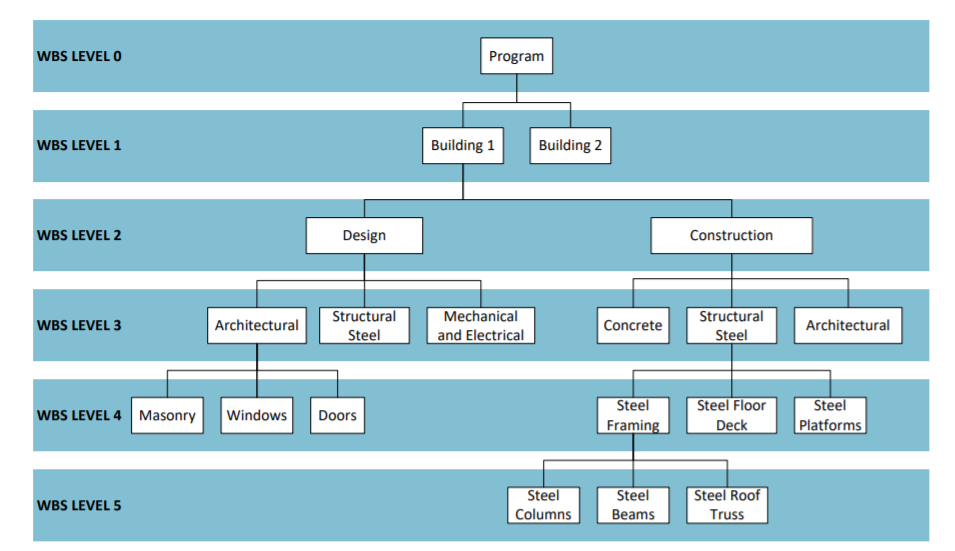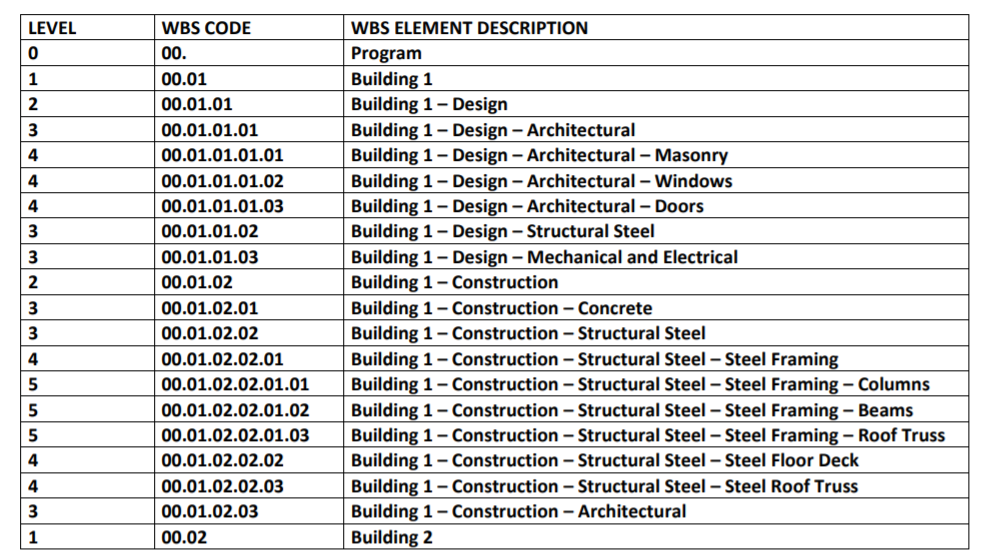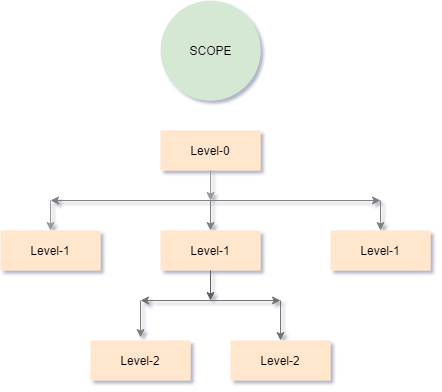Key topics to be understood
- The Product Breakdown Structure (PBS) is super imposed with the actual work that need to be done to construct them to arrive at the Work Breakdown Structure (WBS)
- Once the WBS is defined and baselined, all further estimates will be based on it
- WBS comprises of various levels. As the levels increases the detailing increases
- The lowest level in a WBS are known as Work Packages
- Work packages are chunks of work which can be completed between 8 and 80 hours of work. This is known as 8-80 rule
- The entire scope of the project must be reflected in the WBS. This is known as 100 percent rule
- If something is missed out in the WBS, it will not be there in the final product
- Prior to schedule development, work packages are further decomposed into activities
Work Breakdown Structures are deliverable oriented grouping of work. A Work Breakdown Structure (WBS) is a hierarchical decomposition of the project scope into smaller, more manageable work packages. It organizes project work into hierarchical levels, making it easier to plan, manage, and track project activities. Work packages can be in the form of a tree or list.
WBS tree structure

WBS List structure

Here are examples of Work Breakdown Structures for both Engineering, Procurement, and Construction (EPC) projects and Information Technology (IT) projects:
Example 1: Work Breakdown Structure for an EPC Project (Construction of a Power Plant)
- Project Management
- Project Planning
- Project Coordination
- Reporting and Communication
- Engineering
- Site Survey and Assessment
- Conceptual Design
- Detailed Engineering
- Permitting and Approvals
- Procurement
- Material Procurement
- Equipment Procurement
- Vendor Management
- Construction
- Site Preparation
- Foundation Construction
- Structural Steel Erection
- Installation of Equipment
- Electrical and Instrumentation Work
- Mechanical Installation
- Piping and Plumbing
- Commissioning and Testing
- Pre-commissioning Activities
- Functional Testing
- Performance Testing
- System Integration Testing
- Quality Assurance and Control
- Inspection and Testing
- Quality Audits
- Compliance Verification
- Health, Safety, and Environmental (HSE)
- Safety Planning and Training
- Hazard Identification and Mitigation
- Environmental Compliance
- Project Closeout
- Punch List Completion
- Documentation and Handover
- Lessons Learned
Example 2: Work Breakdown Structure for an IT Project (Development of a Software Application)
- Project Management
- Project Planning and Coordination
- Stakeholder Management
- Risk Management
- Reporting and Documentation
- Requirements Gathering
- Stakeholder Interviews
- User Surveys
- Requirements Documentation
- Design
- Architecture Design
- User Interface Design
- Database Design
- Development
- Frontend Development
- Backend Development
- Database Development
- Testing
- Unit Testing
- Integration Testing
- System Testing
- User Acceptance Testing (UAT)
- Deployment
- Deployment Planning
- Installation and Configuration
- Data Migration
- Training and User Support
- User Training
- Documentation Development
- Help Desk Support
- Maintenance and Support
- Bug Fixes and Updates
- Performance Monitoring
- User Feedback and Improvement
In both examples, the Work Breakdown Structure breaks down the project scope into hierarchical levels, each representing a different aspect of the project. This hierarchical structure makes it easier to organize, plan, and manage project activities, ensuring that all necessary work is identified and accounted for.
100% rule
The 100% rule, also known as the “100% rule of allocation,” is a fundamental principle in Work Breakdown Structure (WBS) development. It states that the sum of the work at the lowest level of the WBS must equal 100% of the work represented by the higher-level parent element. In other words, the WBS should fully decompose the project scope, and every component of the project should be included in the WBS without any gaps or overlaps.
Here’s how the 100% rule works:
- Hierarchy: The WBS is organized hierarchically, with higher-level elements representing major deliverables or phases of the project and lower-level elements representing progressively detailed tasks or work packages.
- Decomposition: Each higher-level element in the WBS is decomposed into smaller, more manageable components at the lower levels. This decomposition continues until the project scope is fully defined and all work required to complete the project is represented.
- 100% Allocation: At each level of the WBS, the work represented by the child elements should collectively add up to 100% of the work represented by the parent element. This ensures that all project work is captured and accounted for within the WBS.
For example, consider a construction project to build a house. The top-level element of the WBS might be “House Construction.” This is decomposed into lower-level elements such as “Foundation,” “Frame Construction,” “Roofing,” “Interior Finishing,” and “Exterior Finishing.” Each of these elements should collectively account for 100% of the work required to complete the “House Construction” phase.
The 100% rule helps ensure that the WBS comprehensively represents the project scope and that no work is overlooked or duplicated. It provides a structured framework for project planning, scheduling, and resource allocation, enabling project managers to effectively manage and control project activities. Additionally, adherence to the 100% rule facilitates accurate cost estimation, progress tracking, and communication of project scope to stakeholders.


Work packages
The lowest level in a WBS is known as the Work package
A work package is a fundamental element of a project’s Work Breakdown Structure (WBS). It represents a discrete, manageable unit of work that contributes to the completion of a project deliverable or objective. Work packages are typically decomposed from higher-level project deliverables and further broken down into smaller tasks or activities that can be planned, executed, and tracked.
Here are key characteristics of a work package:
- Defined Scope: Each work package has a clearly defined scope of work, outlining the specific deliverables, objectives, and outcomes to be achieved.
- Measurable: Work packages are tangible and measurable units of work, with defined criteria for completion and success. They should be specific enough to allow for accurate estimation, planning, and monitoring of progress.
- Assignable: Work packages are assigned to individual team members or groups responsible for executing the work. Assignees are accountable for completing the work package within the specified constraints, such as budget, schedule, and quality standards.
- Time-Bound: Work packages have defined start and end dates, indicating when the work is expected to begin and be completed. Time-bound work packages help project managers track progress, identify delays, and manage project schedules effectively.
- Resource Requirements: Work packages outline the resources, such as personnel, equipment, materials, and budget, needed to accomplish the work. Clear resource requirements enable project managers to allocate resources efficiently and ensure that teams have the necessary support to complete the work.
- Dependencies: Work packages may have dependencies on other work packages, tasks, or project activities. Understanding dependencies helps project managers sequence work effectively, identify critical paths, and manage interdependencies to prevent bottlenecks and delays.
- Control Points: Work packages serve as control points for monitoring and managing project progress. Project managers track the status of work packages, assess performance against predefined metrics or milestones, and take corrective actions as needed to keep the project on track.
Work packages provide a structured framework for organizing, planning, and executing project work, enabling project teams to manage complex projects more effectively. By breaking down project deliverables into smaller, manageable components, work packages help streamline project management processes, improve resource allocation, and enhance overall project success.
Examples of Work Packages for EPC Projects:
- Foundation Construction (EPC – Bridge Construction)
- Excavation
- Formwork Installation
- Reinforcement Placement
- Concrete Pouring
- Curing and Finishing
- Structural Steel Erection (EPC – Industrial Plant Construction)
- Steel Fabrication
- Transportation to Site
- Erection Planning
- Crane Operations
- Welding and Bolting
- Piping Installation (EPC – Oil Refinery Upgrade)
- Pipe Routing
- Pipe Cutting and Beveling
- Pipe Welding
- Pipe Support Installation
- Hydrostatic Testing
- Electrical System Installation (EPC – Power Plant Construction)
- Cable Tray Installation
- Cable Pulling
- Equipment Wiring
- Instrumentation Installation
- Electrical Panel Assembly
- Commissioning and Testing (EPC – Water Treatment Plant)
- Functional Testing
- Performance Testing
- System Integration
- Troubleshooting and Debugging
- Client Acceptance Testing
Examples of Work Packages for IT Projects:
- Requirement Gathering (IT – Software Development)
- Stakeholder Interviews
- User Surveys
- Requirements Documentation
- Use Case Development
- Requirement Prioritization
- System Architecture Design (IT – Web Application Development)
- High-Level Architecture Planning
- Database Schema Design
- Component Specification
- Interface Design
- Security Architecture
- Frontend Development (IT – Mobile App Development)
- User Interface Design
- Screen Prototyping
- Frontend Coding (HTML, CSS, JavaScript)
- UI/UX Testing
- Accessibility Implementation
- Backend Development (IT – E-commerce Platform)
- Database Development (SQL, NoSQL)
- Server-Side Programming (Node.js, Python, Java)
- API Development
- Authentication and Authorization
- Integration with External Systems
- Quality Assurance (IT – Software Testing)
- Test Plan Development
- Test Case Creation
- Functional Testing
- Regression Testing
- Performance Testing
- Deployment and Release (IT – System Implementation)
- Deployment Planning
- Configuration Management
- Data Migration
- Rollout Strategy
- User Training and Support
These examples illustrate how work packages break down project deliverables into smaller, manageable tasks or activities, facilitating effective planning, execution, and monitoring of projects in both EPC and IT domains
80-20 rule based Work package prioritization
The concept of the 80-20 rule can be applied to work packages within a project’s Work Breakdown Structure (WBS). In this context, the rule suggests that a minority of work packages (roughly 20%) often account for the majority of project effort or resources (about 80%). This principle emphasizes the importance of identifying and prioritizing the critical few work packages that contribute most significantly to project success. Here’s how the 8-80 rule can be associated with work packages:
- Identification of Critical Work Packages: Project managers analyze the WBS to identify the critical few work packages that have the greatest impact on project objectives, timelines, and deliverables. These work packages typically involve complex tasks, high resource requirements, or significant dependencies with other project components.
- Resource Allocation: The 8-80 rule suggests that a significant portion of project resources and effort should be allocated to the critical few work packages that contribute most to project success. Project managers prioritize resource allocation, staffing, and budgeting to ensure that these work packages receive adequate attention and support.
- Risk Management: Work packages identified as critical according to the 8-80 rule are often associated with higher levels of risk due to their complexity, dependencies, or impact on project outcomes. Project managers focus risk management efforts on mitigating risks associated with these critical work packages to minimize potential disruptions or delays.
- Time Management: The critical few work packages identified through the 8-80 rule may also consume a significant portion of project time and effort. Project managers prioritize scheduling, task sequencing, and resource allocation to ensure timely completion of these critical work packages, thereby minimizing project delays and optimizing overall project schedules.
- Monitoring and Control: Project managers closely monitor progress and performance of the critical work packages throughout the project lifecycle. By focusing monitoring and control efforts on these key areas, project managers can quickly identify deviations, address issues, and take corrective actions to keep the project on track and mitigate potential risks.
Overall, the application of the 8-80 rule to work packages within a project’s WBS helps project managers prioritize resources, manage risks, optimize schedules, and enhance overall project performance by focusing efforts on the critical few work packages that drive project success.
8-80 rule based work package sizing
The concept of the 8-80 rule can also be applied to work package sizing within a project’s Work Breakdown Structure (WBS). In this context, the rule suggests that work packages should ideally be sized to be neither too small (less than 8 hours) nor too large (more than 80 hours).
Here’s how the 8-80 rule can be associated with work package sizing:
- Avoiding Micro-Tasks (Less Than 8 Hours): Work packages that are too small, typically less than 8 hours in duration, may not provide sufficient granularity for effective tracking and management. Micro-tasks can lead to excessive administrative overhead, increased complexity in scheduling, and difficulty in accurately estimating progress. Additionally, breaking down work into overly small tasks can hinder team productivity and motivation. Therefore, project managers aim to avoid excessively small work packages by consolidating tasks and grouping related activities.
- Preventing Macro-Tasks (More Than 80 Hours): Conversely, work packages that are too large, exceeding 80 hours in duration, may become unwieldy and difficult to manage. Macro-tasks can pose challenges in resource allocation, scheduling, and progress tracking. They may also increase the risk of delays and dependencies, as well as hinder the identification of potential issues and risks. To prevent overly large work packages, project managers decompose project deliverables into smaller, more manageable components, ensuring that work packages are sized appropriately for efficient execution and control.
By adhering to the 8-80 rule in work package sizing, project managers aim to achieve a balance between granularity and manageability. Work packages sized within the optimal range of 8 to 80 hours enable effective tracking, resource allocation, and progress monitoring, thereby enhancing project control and delivery efficiency. Additionally, appropriately sized work packages facilitate clearer communication, better task assignment, and improved team collaboration, contributing to overall project success.
WBS dictionary


